“It therefore only remains for me to extend a warm invitation to the entire Christian community to set out spiritually upon the path of [a] …. pilgrimage. This can be done in many ways … but we must all make that inward journey which seeks to move us away from whatever, in us and around us, is contrary to God’s law, so as to be able to encounter Christ fully, professing our faith in him and receiving the abundance of his mercy.” Saint John Paul II
Watch video introduction here.
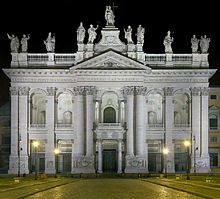
Archbasilica
The Lateran Basilica is the cathedral church of the Diocese of Rome and the official ecclesiastical seat of the Bishop of Rome, who is the Pope. It is the Papal Archbasilica, and it is the oldest public church in the west and ranks first among the four Major Basilicas of Rome, all of which are papal.
As a cathedral of Rome it ranks above all other churches in the Catholic Church, including St. Peter’s Basilica. For that reason, it is titled Archbasilica.
The Archbasilica stands over the remains of a fort of the Roman imperial cavalry bodyguard. After the victory of the Emperor Constantine over Maxentius (for whom the guard had fought) in the Battle of the Milvian Bridge in 312, Constantine dissolved the guard and demolished the fort. He then built the early Christian Basilica over the fort and dedicated it to the Savior in thanksgiving to Him for his victory over Maxentius.
Palace of the Laterani family
The rest of the site was occupied during the early Roman Empire by the Domus (House or Palace) of the Laterani family. The Domus Laterani came into the hands of the Emperor when Constantine married his second wife, Fausta, sister of Maxentius. The palace and land were given by Constantine to Pope St. Miltiades, who held a Council there in 313 to challenge the Donatist schism. Only later, however, during the papacy of Gregory I (590-604), was the church dedicated also to St. John the Baptist and to St. John the Apostle and writer of the Fourth Gospel.
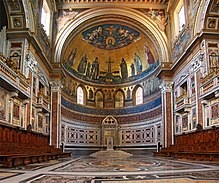
On the 9th of November in 324, Pope St. Sylvester I presided over the official dedication of the Archbasilica and the adjacent Lateran Palace. He declared both to be the “Domus Dei”, the “House of God.” The Papal Cathedra was placed in its interior, making it the Cathedral of the Bishop of Rome. Reflecting the Archbasilica’s claim to being the “mother church,” the words: “Of all the churches in the city and in the world, this is the mother and head of all” are inscribed on the front wall between the main entrance doors.
Every pope beginning with Pope St. Miltiades occupied the Lateran Palace, until the reign of the French Pope Clement V, who decided to transfer the official seat of the Catholic Church to Avignon in 1309.
In the Basilica and the adjoining Palace were held the five Ecumenical Councils of 1123, 1139, 1179, 1215, and 1512-1517, and for this reason, they are called the Lateran Councils.
Destruction
While the popes were in Avignon, the Lateran Palace and the Archbasilica began to deteriorate. Fires in 1307 and in 1361 damaged them badly. Even though the Pope in Avignon sent money to pay for their reconstruction after both fires, the Archbasilica and the Lateran Palace lost their former beauty.
When the Papacy returned from Avignon, and the Pope again resided in Rome, the Archbasilica and the Lateran Palace were thought to be inadequate considering the damage that had accumulated over seven decades. The Popes took up residence at the Basilica di Santa Maria in Trastevere and later at the Basilica di Santa Maria Maggiore. Eventually, the Vatican Palace was built next to the Basilica of St. Peter. The Popes began to reside there and continued to live there until Pope Francis decided to take up residence in the Domus Santa Marta.
Reconstruction
There were many attempts to reconstruct the Archbasilica, but not until Pope Sixtus V (1585-1590) hired the architect, Domenico Fontana was there a definitive plan.
The original Lateran Palace was demolished and replaced with a new building.
On the square in front of the Lateran Palace is the highest and most ancient obelisk in Rome, which has a total of 13 obelisks, more than any other city in the world. This fifteenth century BC monolith once stood in the Karnak temple of Thebes, Egypt. It was brought to Rome and erected in the Circus Maximus in 357 AD. At some point in history it ended up in many pieces and was buried under the Circus Maximus. When it was discovered and excavated in the 16th century, Sixtus V had it placed on a new pedestal in 1588 on the northern entrance to the Archbasilica.
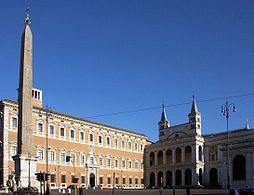
Pope Innocent X (1664-1655) commissioned Francesco Borromini to renovate the interior of the Archbasilica. At this time, St. John Lateran, as we often call this Archbasilica, began to differ from the style of the other three papal basilicas.
Borromini laid out a nave with five aisles, as the nave of St. Peter’s did have and as St. Paul’s still has. However, along the central nave, he did something quite different: he designed 12 niches in a lofty white style, and by 1718, each niche was filled in with a colossal statue of an apostle, sculpted by Roman Rococo artists. Rarely do guide books describe these huge baroque figures of the apostles which are so completely characteristic of the Lateran. The vibrant statues encourage us to meditate on the life and death of the individual apostles aided by the significant symbols that accompany them; for instance, St. Bartholomew with his flayed skin.
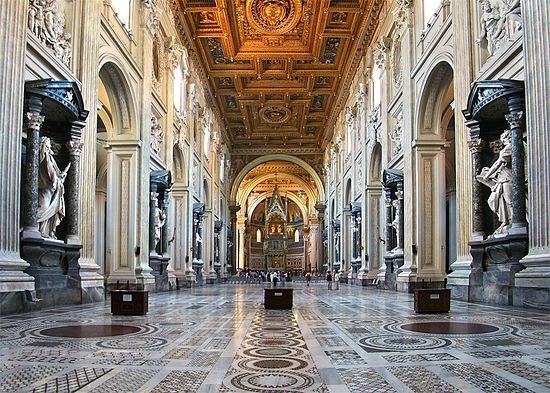
Above these statues are high reliefs in white stucco, designed by Alessandro Algardi in 1659, depicting scenes from the Old and New Testaments. Very interestingly, Algardi and his collaborators created a “biblical concordance,” that is to say, the life of Jesus the Messiah as prefigured in the Old Testament. For instance, on one side of the nave we see the incident of Jonas emerging after three days from the sea serpent. This moment is fulfilled on the other side of the nave by the scene of the Resurrection of Christ.
Pope Clement XII (1730-1740) had an ambitious plan for reconstruction. The façade was designed by Alessandro Galilei, a relative of Galileo, and it was completed in 1735. It looks more like the front of a palace than the front of a church. The inscription of the façade reads (translated from the Latin): “Pope Clement XII, in the fifth year of his reign, dedicated this building to Christ the Savior, in honor of Saints John the Baptist and John the Evangelist.”
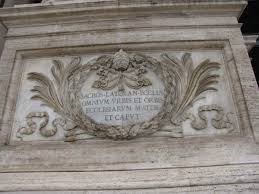
There are five doors giving entrance to the basilica. The rightmost door is the Holy Door, opened every 25 years for the Jubilee. The ritual was performed for the first time in this Basilica by Martin V in 1423 and later extended to the other Roman Basilicas. The entablature bears fifteen colossal statues. In the center stands Christ the Savior with St. John the Baptist and St. John the Evangelist on each side; they are flanked by the 12 Doctors of the Greek and Latin Churches, representing the doctrinal unity of the Church.
The Apse Mosaic
The sanctuary and apse are dominated by a wonderful mosaic executed by two Franciscan friars, Jacopo Torriti and Jacopo da Camerino in the 13th century. The upper part depicts the Savior among the clouds and surrounded by angels.
The lower part depicts (from left to right) St. Paul, St. Peter, St. Francis, Our Lady, St. John the Baptist, St. Anthony, St. John the Apostle, and St. Andrew. A small figure near Our Lady is that of Pope Nicholas IV whose work at the Lateran was praised by Dante in his Paradiso. Above the gemmed crucifix is the Holy Spirit as a dove, from whose beak water flows down the sides of the Cross dividing into four streams, representing the Gospels, to enter finally the Jordan, all along the base of the mosaic, rich with abundant life. From the Gospel sources stags and sheep drink living water. Of course, this is all a symbol of Baptism and the Holy Spirit.
Let us stop and think about these passages from Scripture as we look at the apse mosaic:
“There was a man sent from God, whose name was John. He came for testimony, to bear witness to the light, that all might believe through him. He was not the light, but came to bear witness to the light” (John 1:6-8). John the Evangelist is writing about John the Baptist, the two patrons of the Basilica.
“Behold, the Lamb of God, who takes away the sin of the world! … I saw the Spirit descend as a dove from heaven, and it remained on him… I myself did not know him; but he who sent me to baptize with water said to me, ‘He on whom you see the Spirit descend and remain, this is he who baptizes with the Holy Spirit’” (John 1:29, 32, 33). John the Baptist is speaking about the Savior and the Holy Spirit.
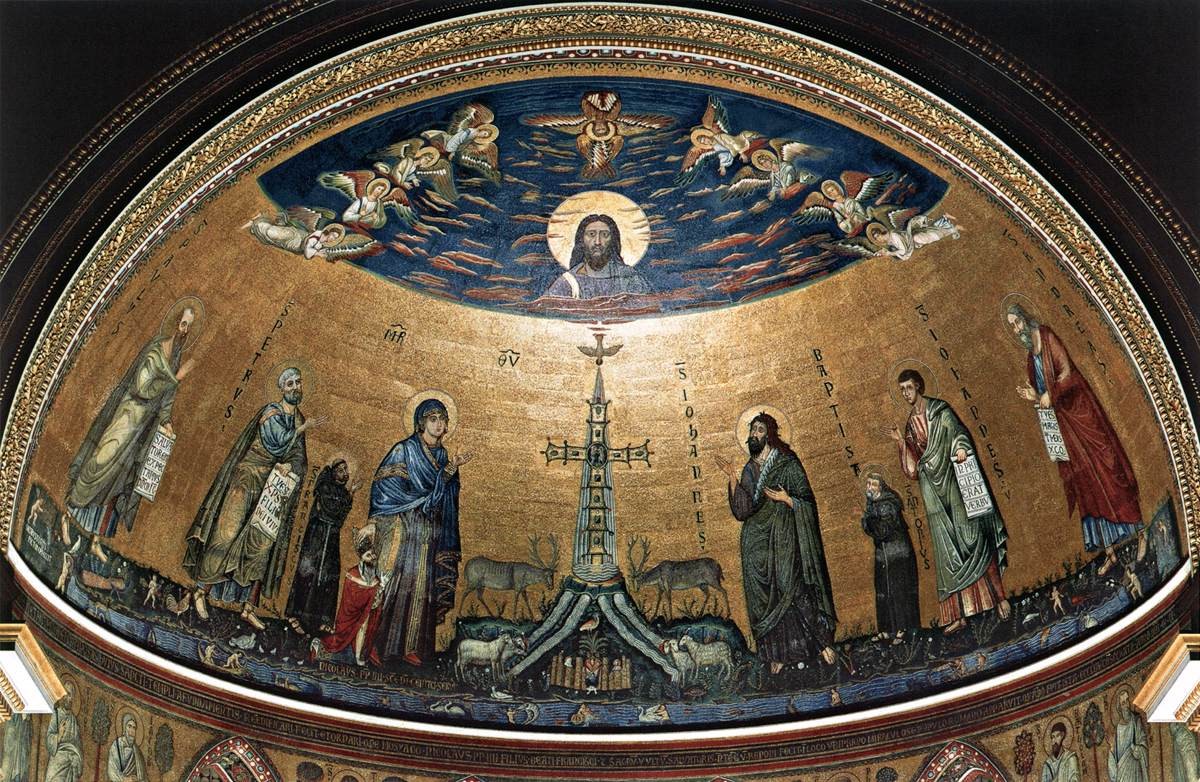
Relics
There are many more aspects of the basilica that we could describe, but then maybe we should wait until you come to Rome.
Let us look now at a few of the many relics that are contained in the basilica.
The canopy or baldacchino over the high altar dates from 1369. It is a Gothic structure that rests on four marble columns and is decorated with paintings. In the upper part of the baldacchino are the busts of the Apostles Peter and Paul. According to tradition the skulls or parts of the skulls of St. Peter and St. Paul are within these busts. They are the great treasure of the basilica.
Under the canopy is the papal altar. Though the altar is a modern construction, it encloses the ancient wooden altar used until the fourth century by the first thirteen popes, from St. Peter to St. Sylvester, to celebrate the Eucharist.
Located to the left of the Papal Altar is another very ancient table. This table rests above the altar where the Blessed Sacrament is reserved. It is placed directly behind a bronze relief of the Last Supper. Tradition claims that it was upon this table that Jesus and the apostles celebrated the Last Supper.
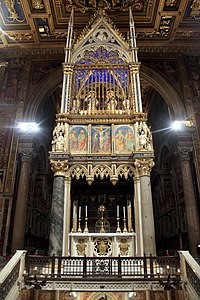
Nearby the Basilica: The Monument of St. Francis and companions
Within a small park just outside of this basilica is a group sculpture of St. Francis (1182-1226) and companions. Francis is depicted facing the façade of the basilica with his arms outstretched. If one stands behind this statue at a certain distance it looks as if St. Francis is holding up the church. This pose recalls the dream of Pope Innocent III in 1209 when he saw the church being supported by St. Francis.
The Poverello from Assisi was in Rome with a few of his followers seeking approval of his new religious family and its rule. Pope Innocent III was sleeping in the Lateran Palace beside the Church which was on the verge of collapse due to the age when wealth and power were sapping its spirituality. In his dream, the Pope saw a man supporting the falling building. Eventually, he recognized in St. Francis the man sent by God to restore, not the material building of the Lateran, but the Church spiritually by means of his poverty and simplicity.
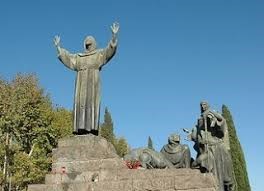
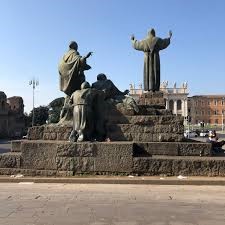
Inside the Basilica: Tomb of Pope Innocent III with Jesus, Dominic and Francis

Scala Santa
Nearby the Archbasilica is the Scala Sancta or Holy Stairs. In 1586, when Sixtus V decided to build the present Lateran Palace, he asked Domenico Fontana, his architect, to use the grand staircase of the old palace, consisting of 28 marble steps. According to legend, St. Helena, the mother of Constantine, brought these steps in the fourth century by ship to Rome from the praetorium of Pontius Pilate in Jerusalem. If they are authentic, Jesus would have used these steps on His way to trial before His Crucifixion. For centuries, many pilgrims have honored the Passion of Christ by ascending the Scala Sancta on their knees. Since the early 1700s, the Holy Stairs have been encased in wood for protection. The stairs remained covered until 2019 when the protective wood was removed for restoration of the stairs. Following restoration, pilgrims were allowed to ascend the exposed holy stairs on their knees for the first time in almost 300 years. The stairs remained open to the public from April 2019 to July 2019 and then covered again in wood.
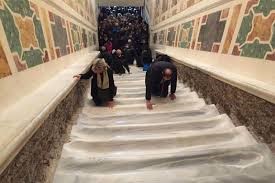
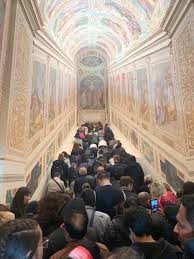
At the top of the Scala Sancta is the Sancta Sanctorum, once the private chapel of the pope.
Baptistery
The baptistery is not part of the Basilica but a separate and detached building close to the Basilica. It is the original baptistery of the Basilica and was founded by Constantine in the fourth century. The building is octagonal in shape with eight porphyry columns supporting the architrave on which are eight smaller columns, also of porphyry.
In the center of the building, we descend by several steps to the basin which forms the actual baptismal font. Candidates went down into the water up to their knees, and water was poured three times over their head. This practice is called partial immersion and was common in the West.
Was Constantine baptized here? No, he was the founder of the baptistery, but he was not baptized here. He deferred the reception of the sacrament of baptism until the very end of his life and was baptized just before his death in May 337. He believed that if he were baptized on his death bed, there would be less chance of sinning and a better chance of getting into heaven. He was baptized by his distant relative, the Arian bishop Eusebius of Nicomedia.
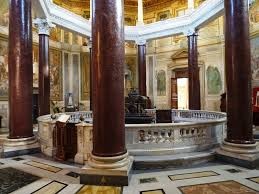
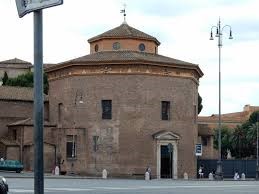
POINTS FOR REFLECTION
*St. John Lateran is the Mother of all the churches of Rome and of the world. Every year the we celebrate the dedication of the Lateran Basilica on November 9. It is the oldest and most dignified of all the Western churches. Besides this universal Feast, on some other day, each diocese celebrates the dedication of its Cathedral. Every individual church remembers its own consecration in a special way, too.
-In Rome there are almost 1000 churches. Wherever I live, do I ever ponder the reality that every church is a symbol of the presence of God among us?
*In the Catechism of the Catholic Church, number 1279, we read that the fruit of Baptism, or baptismal grace, is a rich reality that includes birth into the new life by which man becomes an adoptive son of the Father, a member of Christ and a temple of the Holy Spirit. By this very fact the person baptized is incorporated into the Church, the Body of Christ, and made a sharer in the priesthood of Christ.
-I know this, but how often do I really think about the fact that I am a temple of God and that the Holy Trinity dwells in me by means of grace?
* “For a religious, communion in community is received as gift. It is a sharing in the mystery of the Trinitarian communion and the communion of the Church, a means to holiness, and an urgently needed witness of love to modern culture” (Foundations of Religious Life).
